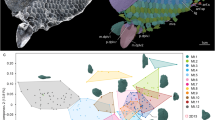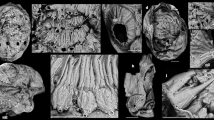Abstract
THE earliest evolution of the chordates and their relationships with other deuterostomes remains controversial1–3. Rejuvenation of interest in the areas of molecular phylogeny4 and developmental genetics5–7 has not been matched by new insights from the fossil record, which for the Lower and Middle Cambrian remains exceptionally sparse. The supposed chordate Emmonsaspis8 has been shown to be a frond-like fossil9, and phosphatic sclerites of hadimopanellids, once compared with vertebrate dermal armour10,11, are now known to be derived from the cuticle of protostome palaeoscolecidan worms12,13. Other fragmentary material of supposed scales is even more dubious14. The best-known candidate in this thin roster remains the Burgess Shale chordate Pikaia15. Here we report a single specimen of a Lower Cambrian chordate, Cathaymyrus diadexus, new genus and species, that is similar to Pikaia but predates it by about 10 million years (Myr). Important features of this new specimen are structures interpreted as pharyngeal gill slits. The evolution of chordates was an integral part of the first stages of the Cambrian 'explosion', and steps to craniates with neural crest were probably achieved by the Middle Cambrian.
This is a preview of subscription content, access via your institution
Access options
Subscribe to this journal
Receive 51 print issues and online access
$199.00 per year
only $3.90 per issue
Buy this article
- Purchase on Springer Link
- Instant access to full article PDF
Prices may be subject to local taxes which are calculated during checkout
Similar content being viewed by others
References
Bone, Q. J. Linn. Soc. (Zool.) 44, 252–269 (1960).
Jollie, M. Zool. J. Linn. Soc. 75, 167–180 (1982).
Jefferies, R. P. S., Brown, N. A. & Daley, P. E. J. Acta Zool. Stockh. 77, 101–122 (1996).
Wada, H. & Satoh, N. Proc. Natl Acad. Sci. USA 91, 1801–1804 (1994).
Satoh, N. & Jeffery, W. R. Trends Genet. 11, 354–359 (1995).
Holland, P. W. H. & Garcia-Fernandez, J. Dev. Biol. 173, 382–395 (1996).
Holland, P. W. H., Koschorz, B., Holland, L. Z. & Herrmann, B. G. Development 121, 4283–4291 (1995).
Durham, J. W. Prac. N. Am. Paleont. Conv. H, 1101–1132 (1971).
Conway Morris, S. Palaeontology 36, 593–635 (1993).
van den Boogaard, M. Scr. Geol. 90, 1–12 (1989).
Märss, T. Eesti NSV Tead. Akad. Toim. Geol. 37, 10–17 (1988).
Müller, K. J. & Hinz-Schallreuter, I. Palaeontology 36, 549–592 (1993).
Conway Morris, S. Zool. J. Linn. Soc. (in the press).
Howell, B. F. Bull. Geol. Soc. Am. 48, 1147–1210 (1937).
Conway Morris, S. in Atlas of the Burgess Shale (ed. Conway Morris, S.) 26 (Palaeontological Association, London, 1982).
Chen, J.-Y., Ramsköld, L. & Zhou, G.-Q. Science 264, 1304–1308 (1994).
Shu, D., Geyer, G., Chen, L. & Zhang, X.-L. Beringeria (special issue) 2, 203–241 (1995).
Conway Morris, S. Trans. R. Soc. Edinb. Earth Sci. 80, 271–283 (1989).
Briggs, D. E. G. & Kear, A. J. Lethaia 26, 275–287 (1994).
Butterfield, N. J. Lethaia 29, 109–112 (1996).
Conklin, E. G. J. Morph. 54, 69–151 (1932).
Peterson, K. J. Lethaia 28, 25–38 (1995).
Shu, D.-G., Zhang, X.-L. & Chen, L. Nature 380, 428–430 (1996).
Chen, J.-Y., Dzik, J., Edgecombe, G. D., Ramsköld, L. & Zhou, G.-Q. Nature 377, 720–722 (1995).
Dzik, J. Acta Palaeont. Pol. 40, 341–360 (1995).
Gould, S. J. Nature 377, 681–682 (1995).
Zhuravlev, A. Yu. Beringeria (special issue) 2, 147–160 (1995).
Sansom, I. J., Smith, M. P., Armstrong, H. A. & Smith, M. M. Science 256, 1308–1311 (1992).
Gabbott, S. E., Aldridge, R. J. & Theron, J. N. Nature 374, 800–803 (1995).
Szaniawski, H. & Bengtson, S. J. Paleont. 67, 640–654 (1993).
Author information
Authors and Affiliations
Rights and permissions
About this article
Cite this article
Shu, DG., Morris, S. & Zhang, XL. A Pikaia-like chordate from the Lower Cambrian of China. Nature 384, 157–158 (1996). https://doi.org/10.1038/384157a0
Received:
Accepted:
Issue Date:
DOI: https://doi.org/10.1038/384157a0
This article is cited by
-
The swimming trace Undichna from the latest Devonian Hangenberg Sandstone equivalent of Morocco
Swiss Journal of Palaeontology (2021)
-
Facts and fancies about early fossil chordates and vertebrates
Nature (2015)
-
Non-random decay of chordate characters causes bias in fossil interpretation
Nature (2010)
-
Community structure and composition of the Cambrian Chengjiang biota
Science China Earth Sciences (2010)
-
The Evolutionary Emergence of Vertebrates From Among Their Spineless Relatives
Evolution: Education and Outreach (2009)
Comments
By submitting a comment you agree to abide by our Terms and Community Guidelines. If you find something abusive or that does not comply with our terms or guidelines please flag it as inappropriate.



